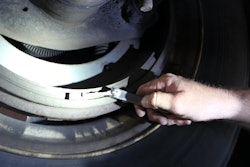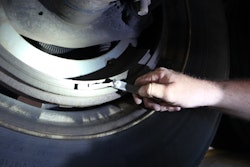Cleanliness is next to godliness”-that’s what Dave Aungst, principal service representative, The Timken Company, had to say when asked how important rigorous wheel-end maintenance is.
“Dirt particles can shorten any component life dramatically,” he said. “A lot of over-the-road trucks operate in relatively clean environments, so the drivers will have their bearings checked every 100,000 miles. Off-highway trucks, like cement trucks, work in a dirtier environment and therefore may need to be inspected more frequently.”
Leslie Kern, senior product manager, SKF vehicle service market, heavy-duty market, said, “When a wheel-end component fails unexpectedly, the truck is put out of service, making it unavailable to deliver goods and earn income for the trucking company.
“One component failure often leads to the demise of other wheel-end components. For instance, if a seal was not installed correctly and it leaks, lubricant levels are reduced causing bearings to fail.
“As bearings start to fail, temperatures rise and lubricants are compromised, accelerating the cycle. High temperatures also can cause hubcap failure on non-drive axles,” she said. “Each wheel-end component affects the others’ longevity.”
In order to protect your customers’ wheel ends as well as the entire vehicle system, you should adhere to the following top five maintenance tips that the experts provided.
- Bob Crepas, product specialist, Dana Corporation, Commercial Vehicle Systems Division, said that the most important thing to remember when maintaining wheel ends is that the wheel end play must be set between .001″ and .005″-the industry standard for heavy-duty vehicles.
“If the bearings are set too tight or too loose, bearing life will drop off dramatically, which eventually could result in a catastrophic failure.
“If the bearings are set at less than .001″ you will induce a preload condition on the bearings, which is very difficult to measure accurately because of the almost endless amount of variables that could be introduced when this occurs,” he said.
“If the bearings are set too loose, greater than .005″, three scenarios may occur. First, excessive wheel end play will introduce camber into the wheel that could cause tire wear and difficulty when trying to align the vehicle. Second, excessive end play will decrease the life of the bearing and could cause the bearing to fail. Lastly, excessive wheel bearing end play will cause wheel seal leaks,” Crepas explained.
“Wheel seals are designed to handle a specific amount of run-out between the seal and the drive axle spindle; if exceeded, they will leak.”
- The experts agreed that it’s vital to follow the Technology & Maintenance Council’s (TMC) recommended wheel-end procedures. Crepas said that the TMC procedures were developed “to ensure that wheel end play adjustment would be consistent and repeatable, and if this process is followed, you should get a consistent and accurate measurement every time.”
He outlined TMC’s procedures.
- While rotating the wheel, torque the inner wheel nut to 200 ft.-lbs.
- Back it off one full turn.
- While rotating the wheel, torque the inner nut to 50 ft.-lbs.
- Back off the inner nut between one-sixth and one-quarter turn depending on the thread count of the spindle nut.
- Last but not least, measure the wheel bearing end play-it must measure between .001″ and .005″.
Kern concurred, adding that bearing adjustments out of the TMC recommended range of .001″ to .005″ can cause early seal and bearing failure. “Service life can range from instant failure to a less-than-optimized service life on excessively overtightened or undertightened bearings. Also, using a dial indicator to verify an adjustment is highly recommended,” she said.
- The proper installation and replacement procedures must be adhered to for optimal wheel-end life.
“Each seal has a unique installation procedure and some require special installation tools, but they can go into an instant failure when the manufacturers’ installation instructions are not followed,” Kern said.
“An incorrect seal installation tool can cock or damage a seal during installation. Choose a seal that matches your customer’s application to optimize service life. Vocations that are high braking, run in dirty environments or use synthetic lubricants require specially-designed seals,” she added.
Be aware that although some synthetic lubricant additive packages can increase bearing life, they may be incompatible with the seal’s rubber material, ultimately shortening the wheel-end life. Therefore, when using synthetic lubricants, be sure to use a seal designed for synthetics, Kern said.
Seal damage may occur as a result of dropping the hub during installation. “A common mistake when installing a wheel hub is to let the outer end of the hub drop or rest on the spindle before the outer wheel bearing cone is installed,” Crepas said.
“The problem is that the wheel seal and inner bearing are preassembled to the hub, and when the inner bearing is fully sealed to the spindle, the hub still can move freely. If the hub moves too far up, down, right or left, the wheel seal can be damaged,” he explained. “To ensure a proper repair, the hub should be installed and held parallel to the spindle until the outer wheel bearing cone is installed.”
Aungst added that it’s important to replace both the cup and the cone together. “Some technicians may see the cup as tight-fitted into the wheel hub, so they wipe it and assume it’s functioning properly. It would take them only 10 minutes to drive it out and put in a new one, but the fact is they just don’t replace the cup as often as they should.
“Technicians must remember that the cup has just as many hundreds of thousands of miles worn into it as the cone. They both must be replaced,” he said.
- Refill the drive axle hub with lubricant after it is removed for maintenance. “There are wheel hubs currently used in the field that do not have a fill hole into which lube should be poured. In these cases, the proper way to refill the hubs is to raise each side of the drive axle 6″ or more off the ground for one minute,” Crepas said.
“This will allow the lubricant from the drive axle housing to run into the hub, filling it to its maximum level. Note that filling the hub with lubricant before it is installed will not ensure that bearing damage will not occur resulting from a lack of lube,” he said.
Kern added that lubricant contamination may cause wheel-end failure. “Lubricants can be contaminated either by water or dirt ingress past the seal or hubcap or from internal metal particles. The bearings often are the source of the metal as they start to wear. Clean and careful handling of the wheel-end components prior to installation will reduce the possibility of contamination,” she explained.
- Leaks should be remedied immediately, especially axle shaft flange leaks. Crepas said that in most cases the root cause for axle shaft flange leaks is improper torque to the axle shaft nuts.
“If the nuts are overtorqued, the threads in the hub will begin to yield. Once the threads are damaged, the joint will lose its ability to retain its clamp load between the hub and axle shaft flange. The only way to resolve this is to replace the hub,” he said.
“If the axle shaft nuts are undertorqued, there will not be enough clamp load to keep the shaft from moving. Any movement between the shaft flange and hub will cause the axle shaft gasket to break down, causing a loss of clamp load resulting in a leak,” Crepas explained. Note that you always should use a torque wrench when installing axle shafts.
Using the proper tools is necessary for proper wheel-end installation and replacement, but more important is the technician’s attention to detail. It is common for one component failure to lead to another, creating bigger problems down the road. It is up to you to notice a problem immediately so that your customers’ wheel ends, and ultimately, their whole vehicles, will be taken care of properly.
For More Information
For more information on wheel ends, you may contact the following companies directly. Other companies offering information on wheel ends can be found in the Truck Parts & Service Aftermarket Buyers’ Guide & Directory as well as in the Buyers’ Guide section on our web site at www.truckpartsandservice.com.
ArvinMeritor, Inc.
Florence, KY
888-725-9355
www.meritorhvs.com
Federal-Mogul Corp.
Southfield, MI
248-354-7700
www.federal-mogul.com
Gunite Corporation
Rockford, IL
800-677-3786
www.gunite.com
Roadranger-Eaton/Dana
Kalamazoo, MI
800-826-HELP
www.roadranger.com
SKF
Elgin, IL
800-882-0008
www.vsm.skf.com
The Timken Co.
Canton, OH
330-438-3000
www.timken.com
Triseal Corp.
Hebron, IL
800-910-7325
www.triseal.com









